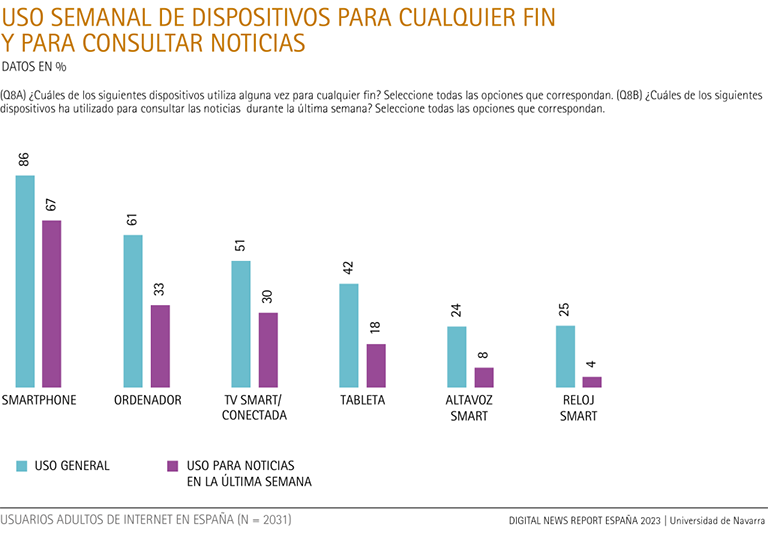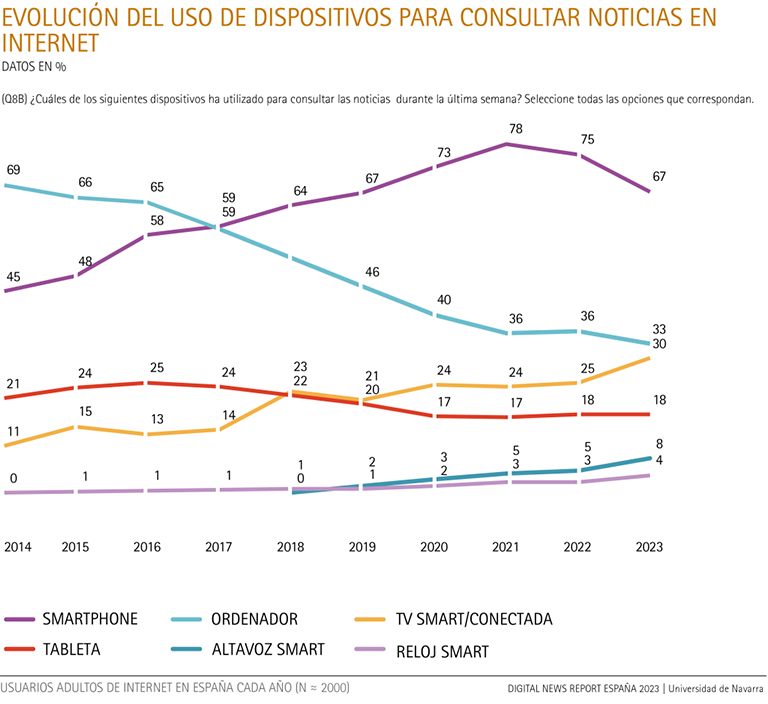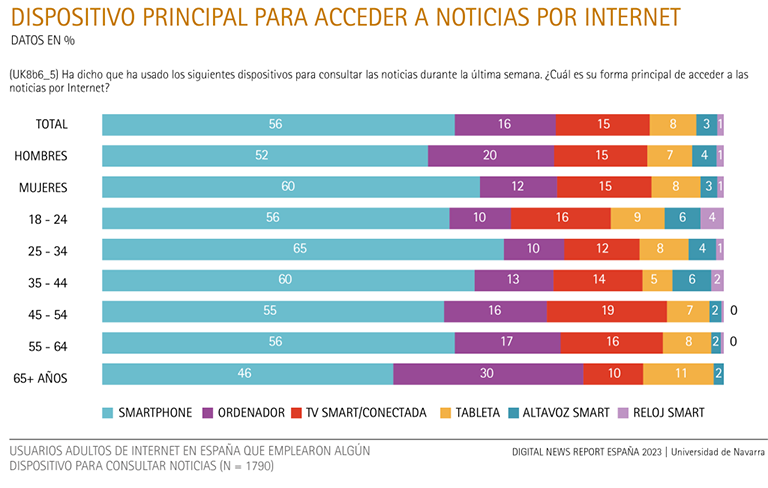-
The computer loses presence: in 2019 it was used by 46% of Spaniards, compared to 33% in 2023.
-
More and more users are getting their information through the smart speaker. Eight percent of respondents use it to listen to news; there are three out of ten (33%) among those who use it regularly.
Methodological clarification
This year's survey has introduced a novelty in the response options referring, on the one hand, to the use of the Android operating system smartphone and, on the other hand, to the use of other phones with Internet connection (such as, for example, older Blackberry models and other basic Nokia phones) available until 2022 in questions Q8A ("Which of the following devices do you ever use for any purpose? Select all that apply"), Q8B ("Which of the following devices have you used to check the news during the week? Select all that apply") and UK8b ("You said that you have used the following devices to check the news during the last week. What is your primary way of accessing news online?"). The change consisted of replacing the previous two possible answers with the following statement: "mobile smart phone (other brand)".
This change has led to a difference B in the percentage of responses counted in the aggregate of users who opt for a smartphone, whether it is an Android device of any brand or an Apple iPhone. Compared to last year, the difference in usage for any purpose is six points (leave from 92% in 2022 to 86% in 2023) and, for the purpose of checking news, it is eight points lower (from 75% to 67%).
Consequently, in this edition of report we will look at the trend in smartphone usage, and avoid comparison with last year.
With this exception in mind, the results of the 2023 survey confirm the trends noted in last year's report regarding the use of various devices to access online news, among which the growth of the smart TV stands out.

Seven out of ten Internet users (67%) use their cell phones to obtain online information
The smartphone continues to be the device most used to consult digital news (67%), followed by far by the computer (33%). There are no significant differences by gender, but there are significant differences by age: 64% among young people aged 18 to 34, but 68% among those over 35. The informative use of cell phones is higher in the 35 to 44 (68%) and 55 to 64 (69%) age groups, with a significant difference with respect to the group of the youngest, 18 to 24 (59%).
Smart TV usage (30%) is approaching that of the computer (33%) as an information device.
Half of respondents (51%) say they use smart TV, while the proportion of users accessing digital news via features or apps installed on the device has grown five points in the past year, from 25% in 2022 to 30% in 2023. Those over 45 years of age make significantly more use (33%) than respondents up to 44 years of age (26%). The data suggest that the smart TV is starting to become an increasingly popular informational alternative to computer use, used by 33% of Spaniards.
Significant differences are found in computer use by gender: four out of ten men (40%), and, among women, only three out of ten users (27%). By age, computer use is significantly higher among those over 45 years of age (35%), compared to group among adults up to 44 (31%). Computer use for information is also much higher among those over 55 years of age (37%), and reaches 44% in the group age group of 65 years and over.
As for other minority devices, there are hardly any major variations in the use of the tablet for information (18%, minus one percentage point). There is a significant difference in use by age: 15% among Internet users aged 18 to 44 and 20% among users aged 45 and over; and it rises to 27% among Internet users over 65 for online information.
On the other hand, there is a six-point increase in the overall use of smart speakers, from 18% in 2022 to 24% in 2023, while the percentage of internet users who use the speaker for information grows by three points, from 5% in 2022 to 8% in 2023. There is also a significant difference in information use by age, with a percentage of 10% among internet users aged 18 to 44 and 6% among those over 45. Specifically, in the group age group 35 to 44, information use is significantly higher (13%).
Finally, the smartwatch also gains eight points in overall usage this past year, from 17% in 2022 to 25% in 2023, and the percentage of Internet users who check the news on their smartwatch reaches 4%. As is the case for the speaker, significantly higher news consumption on this device is observed among internet users aged 18 to 44 (6%), twice as high as for those over 45 (3%). In the group from 35 to 44 years old, the informative use of the smartwatch reaches 7%.

Between 2014 and 2019, smartphone information use added twenty-two points, from 45% to 67%. During the pandemic, it reached 78% in 2021. In 2022, the upward trend of the smartphone seemed to have stopped (75%). This year, following the simplification of the response option, the percentage of informative smartphone use (67%) has equaled the record obtained in 2019. The methodological change makes it advisable to wait for the results of the coming years to note the trend.
As for the computer, the decline has slowed during the pandemic years, and in the last year it has lost three points.
On the other hand, informational use of smart TVs and smart speakers has increased in the last year, with 30% (up five percentage points) and 8% (up three percentage points), respectively.

In addition, the informative use of the devices stands out among those who use them regularly. The graph above shows the percentages of users of the various devices for informational purposes over the percentage of users of each device for any purpose. This calculation points to the trends cited above.
According to this criterion, we found a higher proportion of users of each device than considered over the total number of respondents (n = 2031).
Thus, eight out of ten smartphone users (78%) use it to consult news: although the percentage is four points lower than that obtained last year (82%), the proportion of users is similar.
Six out of ten smart TV users (59%) also use it as a device to access digital news. The resulting proportion is fifteen percentage points higher than in 2022 (45%) and confirms that more and more users are using this device to access digital news.
In contrast, the proportion of computer users who use it to access online news is five points lower than last year (54%; 59% in 2022).
Among tablet users, 43%.
It also highlights that three out of ten regular users of the smart speaker (33%) ask the voice assistant for news: this is five points more than in 2022 and also confirms the increase in users of this device for information. Finally, 16% of users of a smart watchenquiry digital news on the same device.

A further variable in the consideration of the use of devices to consult news is the frequency with which Internet users access digital news: for those who consult the news several times a day (n = 1067), for those who get information once a day (n = 615) and for those who get information several times a week (n = 167). The proportion of users of the devices for informational purposes is higher among those who consult digital news several times a day.
In the case of smartphones, among those who get information several times a day, information use is significantly higher, 74%, compared to 67% among those who get information only once, or for those who get information several times a week (63%).
Forty percent of those who check the news several times a day use a computer to access digital news, compared to 29% of those who get their news only once a day. In this case, the difference is also significant.
On the other hand, among those who get their news several times a day, 35% use a smart or connected TV to access digital news, compared to 28% of Internet users who get their news once a day. No significant differences are found in the use of this device according to the frequency of access to digital news.
Significant differences in smart speaker usage are also found among Internet users who check in several times a day (10%), compared to those who check in once a day (6%) and several times a week (7%).
21% of Internet users who check the news several times a day, 16% of those who check the news only once a day and 10% of Internet users who check the news several times a week use a tablet to access online news. Usage is significantly higher for those who check the news several times a day.
Finally, 6% of Internet users who check the news several times a day, 3% of those who check the news only once and only 1% of Internet users who check the news several times a week use a smartwatch to check the news online. The difference is also significantly greater for those who check the news several times a day.

The graph above sample shows the evolution of the use of devices according to the preference stated by respondents. Despite the change of the statement in the answer option, the smartphone remains the preferred device for the majority (56%). The loss of weight of the computer is B (45 percentage points since 2014), although it has stabilized in the last three years and stands at 16%. Meanwhile, the preferred use of the smart TV has doubled between 2021 (7%) and 2023 (15%). Finally, the tablet registers 8% (it was 5% in 2022), the smart speaker gets for the first time 3% of responses and the smart watch receives 1% to the question about the main device to access news on the internet.

For users aged 18 to 44, the smart TV is already the second most preferred device (14%).
By gender, there is a significant difference in the preferential use of cell phones to access digital news: six out of ten women (60%) and five out of ten men (52%). Also by age: six out of ten Internet users between 18 and 44 years of age (61%) prefer the smartphone for information, and five out of ten (54%) among those over 45 years of age. The proportion of users is higher in the 25-34 (65%) and 35-44 (60%) age groups, significantly higher than among users aged 65 and over (46%).
There is also a significant difference by gender in the preferred use of the computer (16%), 20% among men and 12% among women. By age, Internet users aged 45 and over who prefer the computer (20%) almost double those aged up to 44 (11%). Among respondents over 65 years of age, the percentage is 30%.
The increase in the use of smart or connected TV for digital news is also reflected in the priority choice of Internet users. The percentage of users among adults up to 44 years of age has doubled in the last year, from 7% in 2022 to 14% in 2023. In this age group, group , it is already the second preferred device, three points ahead of the computer (11%). Among those over 45, 16% say they prefer the smart TV (reaching 19% among respondents aged 45 to 54), five percentage points more than in 2022.
The tablet is the preferred device for 8%. Among 18-24 year olds, it is 9%, just one point behind the computer in this age group (10%). Preference is higher among those over 65 (11%).
Finally, the preferred choice for the smart speaker is 6% for adult Internet users up to 44 years of age and finds a higher proportion of enthusiasts in the 18 to 24 (6%) and 35 to 44 (6%) age groups than in the others. This option is a priority for only 2% of those over 45; the difference is significant.